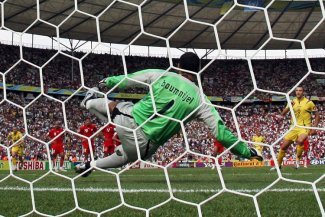France is hosting the Women’s World Cup, organised by international football federation FIFA and the French Football Federation (FFF). The two federations have been talking for months about their efforts to reduce the gender inequalities in football, especially in France. Measures have included hiring new registered players on better terms, creating loyalty among older players by enabling them to train properly and take part in decision-making processes, holding more tournaments and ensuring the matches are televised to increase the visibility of women in the game.
But how much progress has really been made towards the sport earning recognition as a profession offering equal opportunities for men and women or towards changing the public’s perception of women’s football? As this year’s host, France has found itself having to ask itself these questions, knowing that it will be placed under close scrutiny by the international media during the month of June.
Rome was not built in a day, and the feminisation of French football will not happen overnight. But there is a consensus within the FFF that there has been a major shift in the women’s side of the game over recent years. “Everything changed when Noël Le Graët became the president of the French Football Federation in 2011,” recalls Annie Fortems, a pioneer in women’s football. Although the women’s section of the FFF has been around since the 1970s, France’s football executives never showed much interest in developing it, until the year 2012, when the ‘feminisation plan’ was launched.
Although there are nearly 160,000 French women playing the sport in clubs, less than 200 of them currently have a contract (which is usually part-time) and are therefore paid. They earn around €2,400 per month on average (the pay disparities are large amongst women players), whilst the average pre-tax income for men is over €100,000 a month, at Ligue 1 level.
One of the main reasons for this is the fact that France still does not have a professional league for women. But Fortems believes that things will change after the World Cup. “There is a real alignment of the planets in France right now, like there has never been before and there will never be again: the fact that the World Cup is being held here, that politicians are supporting the FFF, that the media is talking about it every day, that sponsors are following the players…all the pieces are in place.”
Frédérique Jossinet has been hard at work on this World Cup ever since she was placed in charge of developing women’s football within the FFF in 2014. “What is at stake here goes far beyond the sporting challenge. What we want to achieve is a level of visibility that will finally put women’s football on the map, across the whole of the country and abroad,” she explains. “And to reach the stage where we stop talking about women’s football and talk about football full stop.”
Driving this enthusiasm is the fact that France is the host nation [as it was for the 1998 men’s World Cup]: “We saw it in 1998 with the men. The fact that it is being held here holds great significance for us, in terms of helping us to move forward and providing us with more financial resources,” continues Jossinet. In addition to the income from the ticket sales for the 52 matches and by-products such as merchandising, the television rights (which have risen substantially since the previous edition in 2015) are a potential windfall that could prove highly beneficial for initiatives seeking to develop women’s participation in the sport. And if FIFA succeeds with its plan to reach over one billion viewers worldwide, the sponsors are very likely to follow.
Still huge disparities
Generating profits is good news for women’s football if, that is, it reaps the benefits in terms of investments. On 1 June 2018, Norwegian player Ada Hegerberg, one of the world’s best players and winner of the Golden Ball in 2018, announced a decision that came as a huge shock: she was boycotting the World Cup to highlight the sexism within football and the lack of opportunities for women players.
It was a personal and political decision made in the wake of a two-year dispute with Norway’s football chiefs. Following a defeat during the Euro 2017 tournament, and having come under criticism from the media in her country, former ‘golden girl’ Hegerberg declined the offer to play for the national team and launched a battle for gender equality centred on her own national federation. “I am Norwegian, and very proud of it. I do not represent my federation, I represent my country. Making a decision like this is by no means easy, but not living up to your own principles and values is even harder,” she said at the time. It was a move reminiscent of what happened in Brazil, in 2017, when several professional women players decided to slam the door on their national team to highlight their frustration at the lack of consideration they are shown by the Brazilian Football Confederation (CBF).
The Norwegian Football Federation finally responded with a decision to bring the women players’ pay into line with the men’s. The women saw their pay doubled, whilst their male counterparts contributed by agreeing to a decrease in their annual income. It was a world-first. Despite this progress, Hegerberg will stay out of the competition, as she still feels “that much remains to be done to improve conditions for women football players”.
Highlighting the wage inequalities still present in France today is like throwing a cat among the pigeons. In her book Pas pour les filles? (Not for Girls?), Mélissa Plaza, a former player for the French national team, says: “As soon as I mention the pay gap, I’m told that the show offered by the men is more profitable and attractive, whilst women only attract an informed public that doesn’t fill the stadiums, far from it.” There is still a long way to go, but female players are increasingly involved in the fight for greater recognition.
In the United States, the women footballers from the national team, the reigning world champions, are engaged in a legal battle. Featured on the cover of Time magazine on 3 June, Alex Morgan, captain of the US team, has denounced the “institutionalised gender discrimination” faced by women players, who earn 40 per cent, on average, of the men’s pay. In a complaint filed last March, they denounced that their federation had paid €4.7 million in bonuses to the men’s team for having only reached the final 16 in the 2014 World Cup, whilst the women, for their victory as the winners of the 2015 World Cup, received a €1.5 million bonus.
The complaint of the three-time world champions is not only related to pay but also to working conditions. They had previously filed a complaint with the United States Equal Employment Opportunities Commission in November 2016, accusing their federation of violating the laws on equal pay. They had reached an agreement in April 2017 and obtained a 30 per cent increase.
In Australia, the national team players have just launcheda campaign directed at FIFA, denouncing the huge gap in the prize money paid to them and to the men. Backed by the union representing Australia’s national women’s and men’s teams, Professional Footballers Australia (PFA), the players are demanding an increase in their share of player generated revenue, which would amount to €64 million rather than the €33 million offered. In a statement to Sports Illustrated, the spokesperson for the PFA, Julius Ross said: “It is the first step of legal action. PFA has briefed an eminent legal team with deep experience in employment law, discrimination, gender pay disputes and human rights. We believe FIFA has, pursuant to its statutes, an obligation to mediate and arbitrate this matter.”
These battles are inspired by those of Scandinavian players. In October 2017, the Danish women’s team staged strike action that culminated with the cancellation of the World Cup qualifier match against Sweden. Why? To put pressure on their federation to pay them enough to cover their commitment to the national team and to sign a collective agreement. They were earning €1,460 a month, on average. By boycotting the match, the Danish team succeeded in obtaining a pay increase, but also compromised its participation in the 2019 World Cup.
The battle against sexism
Along with the struggle to ensure recognition for the women players’ professional status, much work also needs to be done, especially in terms of media coverage and advertising, to free women’s football from stereotypes and prejudice. Talk of ‘a lesbians’ sport’ or football not being ‘a girls’ game’, a player being ‘too muscly for a girl’ or too much of a ‘tomboy’ is still heard all too often.
To fight these stereotypes, Germany’s women players decided to use a bit of humour – but not just that. In a widely broadcast video clip, the eight-time champions of Europe point out that the public does not even know their names and pokes fun at the fact that for their first title they were given a tea service. They also tackle the accusations of ‘excessive manliness’ and say they don’t look to the men for role models but to themselves. Their message is clear: football is ‘their’ game.
For some, this month’s competition will perhaps shatter some preconceived notions, but there will be no escaping the good old clichés. Adèle Bellange, producer of the podcast L’Olympiade Femelle (Women’s Olympiad), covering a mix of feminist issues and sport, acknowledges that the event is also going to “reinforce stereotypes about femininity”.
Bellange says: “The women players are expected to respect certain codes: long hair, earrings, make-up. They have to fulfil society’s expectation of what it means to look feminine. As always, the female form is placed in the spotlight, and they will not be judged on their sporting performance alone. Women players, and the women’s game as a whole, are glamorised.” It is, perhaps, one of the prerequisites they have to fulfil to please the advertisers, who should also review their marketing codes.
Veronica Noseda, an anti-sexism activist within Les Dégommeuses, an association founded in 2012 by female footballers who work with young people in Paris to combat sexist and homophobic mechanisms in sport, holds the same view. “Femininity is mandatory,” she says, emphatically. “To make up for wearing football boots, women players have to be hyperfeminine off the pitch,” she continues. A good illustration of this is the recent official group photo of the Brazilian women’s team, with all the players elegantly crossing their legs the same way.
Things are definitely improving, it is true, but the challenges are still many and varied. For the professional footballers, the World Cup will be, above all, a chance for them to show that they deserve to be taken seriously. To make sure of that, the message repeated every day by all the teams is that they intend to show how skilled they are at the game, and that fair pay and the public’s attention are no more than just rewards.










